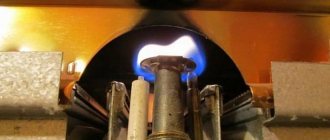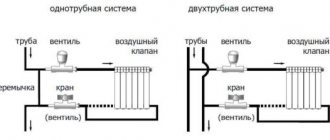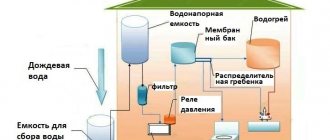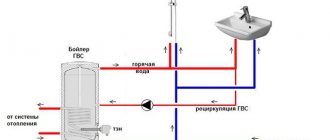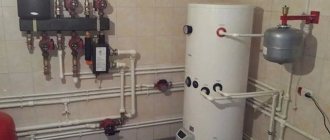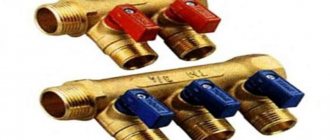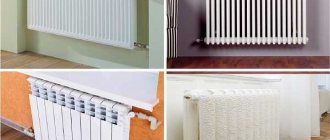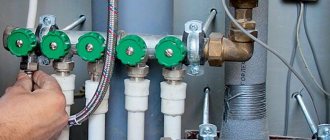Plumbing and heating systems are present in every home. They consist directly of pipes, shut-off and control valves.
During installation, shut-off valves are most often used. Ball valves are in greatest demand. A ball valve is installed in literally every apartment, every house.
Even some plumbers may not understand the difference between a valve and a faucet, although it is obvious. It is not recommended to use a ball valve to regulate water supply due to rapid wear. It is intended only for opening and closing the water in the tap.
The valve can be used to regulate the working flow in any position. Its design can withstand the pressure of water and salts. As a result, the integrity of the structure is maintained and water does not leak.
Adjusting batteries using a thermostat
To ensure constant maintenance of the desired temperature in the room, thermostats for radiators are used.
These devices have other names - thermostatic valve, thermostatic valve, etc. There are many names, but they all refer to one product. The thermal valve and thermal valve are the lower part of the device, and the thermal head and thermoelement are the upper part. Most of these products operate without power sources. The exception is models equipped with a digital screen, in which batteries are placed in the thermostatic head. There is no need to change them often, since the current consumption is negligible.
The radiator thermostat consists of several components:
- thermostatic valve, which is called “housing”, “thermal valve”, “thermal valve”;
- thermostatic head or “thermostatic element”, “thermoelement”, “thermal head”.
The body (valve) is made of metal, usually bronze or brass. Externally, its design resembles a manual valve. Many manufacturers make the lower part of the radiator thermostat unified. This means that different types of heads can be mounted on one housing, regardless of their manufacturer.
Thus, it is possible to install a thermoelement with different controls on the thermal valve - manual, mechanical or automatic, which is very convenient. If you want to change the adjustment method, there is no need to buy the entire device, you just need to install a different thermostatic element.
Automatic regulators differ in the principle of influencing the locking mechanism. In a manual device, its position is changed by turning the handle. As for automatic models, they usually have a siphon that puts pressure on a spring-loaded mechanism. In electronic products, the workflow is controlled by a processor.
The bellows is the main element of the thermoelement (thermal head). It looks like a small sealed cylinder containing liquid or gas inside. Both of these substances have a common property - their volume depends on temperature. When heated, gas and liquid begin to significantly increase in volume and thereby stretch the cylinder.
The bellows, when pressed on the spring, blocks the flow of coolant. When the volume of the working medium decreases as it cools, the spring rises and thereby the fluid flow increases, and the radiator heats up again. Thanks to the use of such a device, depending on its calibration, the set temperature can be maintained with great accuracy - up to one degree.
Before using a radiator, anyone who decides to purchase a thermostat for it must decide what type of temperature control it should have:
- manual;
- auto;
- with built-in or remote sensor.
Adjustment devices
These are mechanical valves or automatic devices with which you can change the heat transfer of the radiator. Mounted on both single batteries and groups of them.
Ball valves
They are used to open or stop the flow of coolant. They are installed together with bypasses in front of radiators or entire sections of the heating system.
A ball valve consists of a body with an internal metal sphere. There is a hole inside it, which in the “open” position does not create obstacles to the movement of liquid. When the tap is closed, the sphere turns with its blind side and blocks the gap.
A ball valve can also operate in an intermediate position, but it is not advisable to leave it in a half-open state for a long time. At a high temperature of the coolant, the ball can stick to the walls, which subsequently causes breakdowns.
Needle taps
Valves of this design can smoothly regulate liquid flow, which directly affects the temperature in the heating radiator. The cast body houses a cone-shaped rod driven by a handle. When the handle is rotated, the needle moves into the canal, closing or opening the passage. The tip can be non-rotating, spherical, with a soft nozzle, which allows for smoother adjustment.
Needle valves can be operated manually or automatically. Additionally equipped with temperature sensors and an electric drive.
Mechanical thermostat
Designed to regulate and constantly maintain the set temperature in the radiator. It is a mechanical valve that cuts into the coolant supply pipe. At the top of the device there is a thermal head for setting the desired mode.
The thermostatic head is an element sensitive to temperature changes. Inside it is an elastic cylindrical bellows filled with gas or liquid with a high coefficient of thermal expansion. When heated, it increases in volume and moves the rod, thereby reducing the clearance of the pipe. The flow intensity drops, the radiator cools.
Mechanical thermostats allow you to control the microclimate in a room without constant human control. The specified mode will be maintained automatically. The main conditions for long-term operation of the valve are that high-quality non-freezing liquid or specially prepared water must circulate in the system, since the device is sensitive to contamination.
Automatic thermostat with remote sensor
Such devices consist of two parts - a mechanical thermal head and a temperature sensor, which are connected by a thin capillary tube 1-10 m long. The capillary mechanical thermal sensor is used to maintain a given temperature in the operating range from 30 to 90 ° C. Can be used both to start valves and to turn on/off the circulation pump.
Electronic thermostat
These are the latest generation devices that allow you to create a favorable temperature in the room using a microprocessor built into the thermal head. Operates on batteries in two control modes:
- as standard, a constant temperature is maintained, which can be set using touch buttons or via radio.
- in programmable mode - the sensor regulates the temperature by hour and day of the week, the temperature schedule is set from a radio remote control or using various applications from a smartphone, tablet or computer.
Automatic thermostats with sensors help remove excess load from the heating system, save on heating the premises in the absence of residents, and make the conditions in each room as comfortable as possible.
Balancing valve
The design of a valve for regulating heating differs from a conventional ball valve in that it can smoothly close the flow area in a few turns. Moreover, after balancing, the position of the valve can be fixed so that no one accidentally violates the settings. This type of control valves is installed at the outlet of the radiator, as shown in the diagram:
Shown here is the connection to a two-pipe horizontal system, most common in private houses and apartments with individual heating. By the way, the principle of installing fittings with a single-pipe scheme remains the same. A regular ball valve is installed on the supply line, and an adjustment valve is installed on the return line. In the case when a two-story house has a system with vertical risers, the installation diagram of the accompanying fittings looks like this:
The principle of product selection is the same as in the previous section
Straight or angular design is accepted depending on the layout of equipment and pipelines; it is also important to use American designs during assembly
Pay special attention to the quality of casting and the thickness of the brass walls of the fittings. If you have networks made of polypropylene pipes, do not rush to buy PPR taps; it is better to install adapters and reliable metal products
Advice. Balancing valves are installed on all radiators, except for the very last one, located at the dead end of the branch. It is enough to install simple ball valves on the connections to it.
Ways to increase the heat transfer of batteries
The presence/absence of the opportunity to increase heat transfer depends on the calculation of the radiator power reserve. If the device is not able to produce more thermal energy, then no fittings will help.
You can try to change the situation in one of the following ways:
- First of all, you should check whether the filters and pipes are clogged. Blockages form both in old buildings and in new buildings, as various construction debris enters the system. When cleaning does not produce results, drastic measures need to be taken.
- Increase in coolant temperature. This can be done if there is an autonomous heating supply, but with centralized heating it is unlikely.
- Changing the connection type. Not all battery connection methods are equally effective. For example, a reverse side connection reduces power by about a quarter. The location of installation of the device also affects the heat transfer.
- Increasing the number of sections. If the location and method of connecting radiators are chosen correctly, and the room is also cold, this means that the thermal power of the devices is not enough. Then it is necessary to increase the number of sections.
If the heating system is equipped with batteries with temperature control, then they require a certain power reserve and this is their main drawback. As a result, heating installation costs increase, since each section costs money.
Comfort cannot be achieved if the room is cold or too hot, so adjusting the heat in radiators is a universal solution to this problem.
How to regulate radiators
To understand how temperature regulation occurs, let’s remember how a heating radiator works. It is a labyrinth of pipes with different types of fins to increase heat transfer. Hot water enters the radiator inlet, passing through the labyrinth, it heats the metal. This, in turn, heats the air around it. Due to the fact that modern radiators have specially shaped fins that improve air movement (convection), hot air spreads very quickly. During active heating, there is a noticeable flow of heat from the radiators.
This battery is very hot. In this case, the regulator needs to be installed
From all this it follows that by changing the amount of coolant passing through the battery, you can change the temperature in the room (within certain limits). This is what the corresponding fittings do - control valves and thermostats.
Let's say right away that no regulators can increase heat transfer. They only lower it. If the room is hot, install it; if it’s cold, this is not your option.
How effectively the temperature of the batteries changes depends, firstly, on how the system is designed, whether there is a reserve power of the heating devices, and secondly, on how correctly the regulators themselves are selected and installed. The inertia of the system as a whole, and the heating devices themselves, plays a significant role. For example, aluminum heats up and cools down quickly, while cast iron, which has a large mass, changes temperature very slowly. So there is no point in changing anything with cast iron: it takes too long to wait for the result.
Options for connecting and installing control valves. But to be able to repair the radiator without stopping the system, you need to install a ball valve before the regulator (click on the picture to enlarge its size)
Automatic regulators
Man by nature is a creature who constantly tries to make his life easier, including everyday life. Therefore, along with manual radiator regulators, there are also automatic ones.
The advantage of automatic regulators is that once you have set the desired battery temperature, you can forget about adjusting again for a long time.
Automatic adjustment is carried out using thermostats and three-way valves.
Adjustment by thermostats
Thermostatic temperature controllers for heating radiators have many names, but the essence does not change. You need to understand for yourself that the automatic regulator is divided into two main parts:
Thermostatic valve (thermovalve)
Thermostatic head (thermal head)
When we talked about manual control valves, they already have a thermal valve as such. Therefore, if necessary, you can turn your manual radiator valve into an automatic one at any time by purchasing an additional thermal head and screwing it onto the thermal valve without any problems.
When, as a thermal valve, there are no wide differences in design features, thermal heads are represented by a wide selection and functionality. From simple ones to thermal heads with a remote room temperature sensor and electronic control. Perhaps the choice is limited only by the consumer’s wallet.
Simple thermal heads do not require electrical power. They work using a special capsule containing liquid or gas. The contents of the capsule expand or contract as the temperature changes and presses with a certain force on the thermal valve rod, changing the rate of coolant flow into the radiator.
More expensive thermal heads equipped with a display require a power supply in the form of a battery, but, as a rule, one battery lasts for a long time.
They may also require constant power from the network, for example, if there is a “smart home” system
Adjustment by three-way valves
The use of a three-way valve to regulate the temperature of radiators is rare in practice, since if you compare the price of one “three-way valve” and a conventional radiator regulator, the latter will cost less.
But still, a few words need to be written about this method. A three-way valve is installed on the radiator supply pipe, however, the following diagram visually shows this:
The same thermal head, which was already mentioned above, is screwed onto the three-way valve, on which the necessary parameters are set.
As soon as the coolant temperature approaches the set value, the three-way valve begins to pass water through the bypass, past the radiator.
Perhaps this is all the comprehensive material on the topic of adjusting the heating radiators of an apartment and private building. We hope you found it useful.
«>
Why do you need to make adjustments?
The main factors explaining the need to change the heating level of batteries using locking mechanisms and electronics:
- Free movement of hot water through pipes and inside radiators. Air pockets may form in the heating system. For this reason, the coolant stops heating the batteries, as it gradually cools. As a result, the indoor microclimate becomes less comfortable, and over time the room cools down. To maintain heat in the pipes, shut-off mechanisms installed on radiators are used.
- Adjusting the temperature of the batteries makes it possible to reduce the cost of heating your home. If the rooms are too hot, by changing the position of the valves on the radiators you can reduce costs by 25%. Moreover, reducing the heating temperature of the batteries by 1°C provides savings of 6%.
- In cases where radiators heat up the air in the apartment very much, you have to open the windows often. It is not advisable to do this in winter, because you can catch a cold. To avoid having to constantly open windows in order to normalize the microclimate in the room, regulators should be installed on the batteries.
- It becomes possible to change the heating temperature of radiators at your discretion, and individual parameters are set in each room.
Adjusting the battery temperature by flow or return
A more global solution to the problem of energy redistribution in the system can be achieved by adjusting the batteries by supply or return. The coolant is directed from more heated areas to less heated ones using balancing valves. This intensity control is called hydraulic balancing of the heating system. All work is carried out, as a rule, by a specialized organization.
If in your house in some apartments the air temperature is more than +25°C, and in others less than +15°C, there is a hydraulic imbalance (+21°C is considered the standard). Another sign of a problem with the system is constant noise in radiators and pipes.
Balancing using the classical method, that is, changing the settings of boiler equipment, does not lead to any positive result. The temperature of the coolant, and therefore the air, either drops in all rooms or rises. At the same time, installing thermostats on all radiators in the house is a labor-intensive and expensive task.
You can achieve results much faster and more efficiently if you install special balancing valves on pipes longer than 10 meters, as well as in areas remote from the circulation pump. They provide the necessary pressure drop on the risers of the system, creating an obstacle to the passage of excess coolant volume and directing it to areas with a deficiency.
Each valve is individually adjustable. The pressure difference regulates the change in the valve flow area. Preliminary hydraulic calculations are made by the design organization. Private individuals do not have access to balancing; this work is carried out only by construction and installation teams.
Why are there taps on radiators?
Each heating device is a separate element of the system that requires adjustment and periodic maintenance. If you control the coolant flow through the batteries depending on the heat demand, you can achieve good results in terms of energy savings. That is, radiator valves and heating taps are designed to solve the following problems:
- Complete isolation of the heating device from the system.
- Restriction of coolant flow through the battery.
- Change in coolant flow depending on external conditions.
- Bleeding air from the radiator and piping network.
There are many situations in which it is difficult to do without disconnecting the battery. For example, properly working central heating in the middle of spring, when it’s already warm outside, but it’s just hot in the apartment. Another case is the need to remove a heating device for the purpose of replacement, flushing or repair. In the absence of shut-off valves, carrying out any action with the radiator becomes problematic.
Valves are also installed on batteries in retro style
Restriction of the flowing coolant is carried out in order to balance individual heating in a private house or apartment
No matter what type of heating system you have, without balancing with valves, the first radiators will always receive more water than the last ones. Limiting the coolant flow at the beginning of the network and thereby balancing all devices with each other is the task of the control radiator fittings
Automatic control of the flow of incoming coolant is a way to save energy used to heat the house. If each tap on the heating radiator maintains the set air temperature in the room by controlling the flow of water through the radiator, then in general the system will consume only the required amount of heat, no more. And this is a considerable saving.
Well, the problem of air release when filling the system or during operation is also solved by special air valves installed on all modern radiators. Below is a list of types of shut-off and control valves, listed in the same order as the tasks they solve:
- Half-turn ball valves in straight and angle versions. Made from brass, bronze or polypropylene with a metal insert.
- Balancing valves for radiators – straight and angular.
- Regulating valves with thermal heads (thermostatic valves).
- Air drain valves – automatic and manual.
For reference. Some home craftsmen use three-way mixing valves to connect heating appliances. But such a solution is unreasonably expensive and is rarely used in practice.
Now we should consider in detail which taps are best installed on radiators in various conditions and circumstances. Some options are clearly shown in the video:
Features of adjusting heating radiators made of cast iron
Utility services often sin by setting a single standard coolant temperature for the entire heating season. Cold weather can come much later, thaws are possible in winter, and spring often comes earlier than schedule. And all this time, apartment residents suffer from unbearable heat.
Older apartment buildings usually have cast iron batteries. To save yourself from suffering, it is quite possible to modernize them a little by installing a thermostat on each radiator or group of devices.
Automatic thermal heads are not used for cast iron batteries. They give a large error due to the fact that cast iron reacts very slowly to changes in coolant temperature. This material has great thermal inertia - once it warms up, it takes a long time to cool down. Therefore, to regulate batteries, it is optimal to use mechanical thermostats with manual adjustment.
Regulating taps can be installed not only on the supply, but also on the return. With a single-pipe system, a bypass with valves is installed to discharge the coolant. If it is impossible to interfere with the heating operation, you will have to reduce the air temperature in the room by other means - protection from heat-insulating boxes or screens.
Valves and taps
Such fittings are a heat exchanger of a shut-off device. This means that the radiator is adjusted by turning the tap/valve in the desired direction. If you turn the fittings 90° all the way, the flow of water into the battery will no longer flow. To change the heating level of the heating device, the locking mechanism is set to the half position. However, not every fitting has this opportunity. Some faucets may leak after a short period of use in this position.
Installing shut-off valves allows you to manually regulate the heating system. The valve is inexpensive. This is the main advantage of such fittings. In addition, it is easy to operate, and changing the microclimate does not require special knowledge. However, there are also disadvantages to locking mechanisms, for example, they are characterized by a low level of efficiency. The battery cooling rate is slow.
Stopcocks
A ball design is used. First of all, it is customary to install them on a heating radiator in order to protect housing from coolant leakage. This type of valve has only two positions: open and closed. Its main task is to turn off the battery if such a need arises, for example, if there is a risk of flooding of the apartment. For this reason, shut-off valves are cut into the pipe in front of the radiator.
If the valve is in the open position, the coolant circulates freely throughout the heating system and inside the battery. Such taps are used if the room is hot. The batteries can be turned off periodically, which will reduce the air temperature in the room.
However, ball locking mechanisms must not be installed in the half position. With prolonged use, the risk of leakage in the area where the ball valve is located increases. This is due to gradual damage to the locking element in the form of a ball, which is located inside the mechanism.
Manual valves
This group includes two types of fittings:
- Needle valve. Its advantage is the possibility of half installation. Such fittings can be located in any convenient position: completely opens/closes the access of coolant to the radiator, significantly or slightly reduces the volume of water in heating devices. However, there is a drawback to needle valves. Thus, they are characterized by reduced throughput. This means that after installing such fittings, even in a fully open position, the amount of coolant in the pipe at the battery inlet will be significantly reduced.
- Control valves. They are designed specifically to change the heating temperature of batteries. The advantages include the ability to change position at the user’s discretion. In addition, such fittings are reliable. There is no need to frequently repair the valve if the structural elements are made of durable metal. There is a shut-off cone inside the valve. When you turn the handle in different directions, it rises or falls, which helps to increase/decrease the flow area.
Control valves for radiators
To manually regulate the operation of heating devices, special valves are used. Such taps are sold with straight or angular connections. The procedure for regulating heating batteries using these devices manually is as follows.
When the valve is turned, the shut-off cone lowers or rises. In the closed position, the coolant flow is completely blocked. Moving up or down, the cone regulates to a greater or lesser extent the amount of circulating water.
Due to this operating principle, such valves are also called “mechanical temperature controllers”. They are installed on batteries with threads, and connected to pipes with fittings, most often of the crimp type.
The control valve used for heating devices has the following advantages:
- the device is reliable, it is not dangerous from blockages and fine abrasive particles present in the coolant - this applies exclusively to high-quality products in which the valve cone is made of metal and carefully processed;
- the product has an affordable price.
Control valves also have disadvantages - each time you use the device, its position has to be changed manually and for this reason it is quite problematic to maintain a stable temperature regime.
For those who are not satisfied with this procedure and are thinking about how to regulate the temperature of the radiator using another method, the use of automatic products that allow them to control the degree of heating of the radiators is more suitable.
Ball Valves
Valves are cheap, but at the same time ineffective control devices. Ball valves are often installed at the entrance to the radiator, with the help of which they regulate the flow of water.
But this equipment also has another functionality - shut-off valves. Valves are used to completely shut off the flow of coolant into the system. For example, in the event of a leak in a heating device, ball valves located at the inlet and outlet of the radiator allow repairs to be made without stopping the heat supply and draining the liquid.
Heating radiators in the apartment cannot be adjusted using ball valves. They have only two positions - completely closed and open. An intermediate position only brings harm.
The fact is that inside such a faucet there is a ball with a hole, which in its normal position is not in danger, but in all other situations the solid particles present in the coolant grind it down and pieces break off from it. As a result, the tap will not be sealed and in the “closed” position, water will continue to flow into the battery, which can lead to big troubles if the device leaks.
If one of the property owners decides to control the radiators using ball valves, you must remember that they should be installed correctly.
This method is usually used in apartment buildings. If the wiring is single-pipe vertical, then the hot water pipe enters the room through the ceiling and a radiator is connected to it (read: “Correct adjustment of heating radiators in an apartment - comfort in the home and saving money”). The pipeline departs from the second entrance to the device and is directed through the floor to the room below.
In this case, it is necessary to install the taps correctly, since the installation of a bypass is mandatory. The bypass pipe is needed so that when the liquid flow to the radiator is closed, the coolant continues to circulate in the general house system.
In some situations, the tap is placed on the bypass to change the amount of water passing through it and thereby adjust the heat transfer of the battery. To ensure greater reliability of the heating system, at least three valves are installed: two will be shut-off valves on the radiator and function normally, and the third will become a regulating valve.
But here we must not forget what position the devices are in. Otherwise, you can completely block the riser and you will not be able to avoid the cold in the apartment, as well as unpleasant showdowns with neighbors and representatives of the management company.
Why is it not recommended to open the ball valve halfway?
There is a lot of varied content on the Internet in which the user is informed that the ball valve is prohibited from opening halfway. The interpretation of these articles is somewhat contradictory.
Let's start with the fact that the tap CAN be opened halfway, a third, a quarter - to any operating position that is convenient for you and that you need at the current moment. But you CANNOT leave him in this position for a long time, and here's why. When the tap is fully opened, water flows through the functional hole of the ball freely, without encountering any obstacles on its way. Completely closing the ball valve ensures that the water flow is shut off and the edge surfaces of the ball component are also not affected.
The situation is different when the ball valve is half open. In this situation, the inner ball element is turned with the hole to the side, and lime deposits form over time on the edges of the internal passage of the ball due to the flow of water. After a certain amount of time, when trying to turn the faucet, this can cause damage to the sealing and fixing components, which will lead to a violation of the tightness of the faucet, or to the failure of the control thread of the ball element, which will make it impossible to open or close the faucet. As a result, the question naturally arises about the need for its repair or complete replacement.
Manual regulators
Manual adjustment is made by a valve installed on the pipes supplying or discharging the coolant from the battery. The diagram, depending on the type of heating system (two-pipe or single-pipe), is slightly different:
Everything is simple here, it gets hot - close the valve, cold - open it.
The radiator is additionally equipped with another valve so that if a leak appears on the radiator, it can be repaired or the radiator can be replaced without shutting down the entire system.
How not to regulate the radiator temperature
Perhaps we need to focus your attention on one important thing. That to adjust radiators you need to install valves, not ball valves
Often, two ball valves are installed on radiators in case of emergency situations when this area requires urgent repairs. These taps make it possible to carry out repairs without draining the heating system or shutting off the common riser of the house. Some regulate batteries with them. This is not worth doing.
Ball valves are shut-off valves; they have only two operating positions, open or closed. It does not have any intermediate working positions. Yes, it will reduce the rate of coolant passing through the radiator as much as you need it. But his days will be numbered. The fact is that when the position of this tap is between “open” and “closed”, the ball, covered with a protective layer, begins to be destroyed by small particles in the form of sand, scale, rust, located in the coolant. Especially in central heating coolant. In places where the layer is damaged, lime deposits, rust, etc. begin to be deposited.
As a result, the faucet handle and the ball first stop spinning, and then begin to leak altogether. Which will lead to a situation where it will be necessary to drain all the water from the heating system and shut off the riser of the house, because the tap that was designed for this no longer works.
Which valves to use for adjustment
To regulate the temperature of heating radiators, special radiator control valves are used. They are specifically designed for use in heating systems, both individual and central. They are resistant to coolant containing solid particles and are also capable of high throughput. They exist with both direct and angular connections.
These valves are reliable, durable, affordable, and effectively cope with their intended purpose. The only disadvantage of manual regulators is periodic monitoring and adjustment. You have to tighten it from time to time, sometimes to a greater or lesser degree, depending on the climate outside, the temperature of the coolant and the room.
Types of heating systems
In a one-pipe system, the coolant is supplied through one large-diameter pipe, to which heating devices are connected in series. The entrance to the radiators is made in the upper part of the device with a pipe of smaller diameter than the main one, and the outlet is made by the same pipe in the lower part. A shut-off valve is installed on each heating radiator, and a special closing section of the pipe, called a bypass, is also installed. If you block the flow of coolant through the radiator, circulation through the main line will not be disrupted thanks to the bypass. Due to the heat transfer of the radiators, the coolant gradually cools down, so that the heating devices furthest from the heat generator (boiler) heat up less than the closest ones, so adjusting the temperature of the heating radiators is especially necessary here.
Single-pipe and two-pipe heating systems
A two-pipe system includes two pipes through which the coolant moves - supply and return. Heating devices are connected to the supply pipe in parallel, and the entrance to the radiator can be in the upper or lower part. The coolant in a two-pipe system approaches each device at the same temperature. In this system, radiators are also equipped with shut-off valves.
Summarizing
You can regulate heating radiators using several types of devices, but experts believe that the best solution is to use special control valves. Such products are manual taps and automated products - thermostats, and only in some cases can a three-way valve with a thermal head be used.
In high-rise apartments with centralized heating, it is better to give preference to control taps or a three-way valve. As for individual heating systems, the problem of how to reduce the temperature of the coolant in a heating radiator is solved using thermostats.
If the apartment owner still prefers automatic adjustment of radiators, then a filter should be installed before the thermostat - it will trap most of the various impurities.
So the temperature in different rooms of a residential building must vary for comfortable living. For example, the bedroom should be cooler than, for example, the living room. Therefore, already at the stage of design and installation of the heating system, it should be possible to do this. And if this has not been done, then it must be done if necessary.
But before you start upgrading your heating system, you need to understand one thing. Adjustment of radiators from the initial temperature is only possible in the direction of lowering the temperature. It is impossible to raise it higher than what was set by the regulators.
